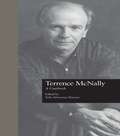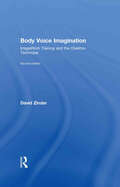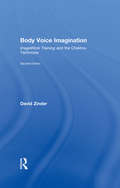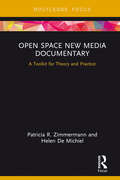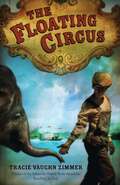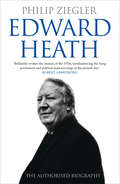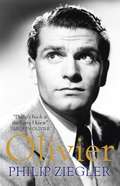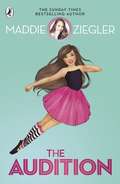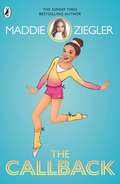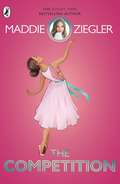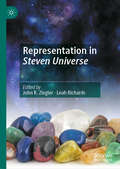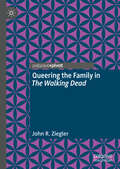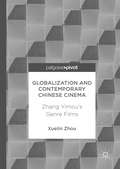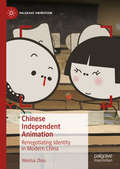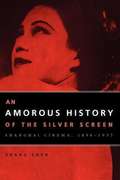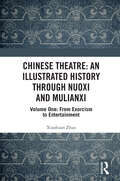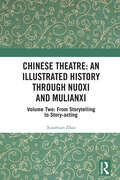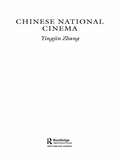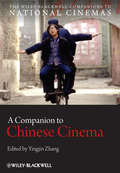- Table View
- List View
Terrence McNally: A Casebook (Casebooks on Modern Dramatists)
by Toby Silverman ZinmanFirst Published in 1997. Routledge is an imprint of Taylor & Francis, an informa company.
Body Voice Imagination: ImageWork Training and the Chekhov Technique (A\theatre Arts Book Ser.)
by David ZinderFirst published in 2008. Routledge is an imprint of Taylor & Francis, an informa company.
Body Voice Imagination: ImageWork Training and the Chekhov Technique
by David ZinderFirst published in 2008. Routledge is an imprint of Taylor & Francis, an informa company.
Open Space New Media Documentary: A Toolkit for Theory and Practice (Routledge Studies in Media Theory and Practice)
by Patricia R. Zimmermann Helen De MichielOpen Space New Media Documentary examines an emerging and significant area of documentary practice in the twenty-first century: community-based new media documentary projects that move across platforms and utilize participatory modalities. The book offers an innovative theorization of these collaborative and collective new media practices, which the authors term "open space," gesturing towards a more contextual critical nexus of technology, form, histories, community, convenings, collaborations, and mobilities. It looks at a variety of low cost, sustainable and scalable documentary projects from across the globe, where new technologies meet places and people in Argentina, Canada, India, Indonesia, Peru, South Africa, Ukraine, and the USA.
Open Space New Media Documentary: A Toolkit for Theory and Practice (Routledge Studies in Media Theory and Practice)
by Patricia R. Zimmermann Helen De MichielOpen Space New Media Documentary examines an emerging and significant area of documentary practice in the twenty-first century: community-based new media documentary projects that move across platforms and utilize participatory modalities. The book offers an innovative theorization of these collaborative and collective new media practices, which the authors term "open space," gesturing towards a more contextual critical nexus of technology, form, histories, community, convenings, collaborations, and mobilities. It looks at a variety of low cost, sustainable and scalable documentary projects from across the globe, where new technologies meet places and people in Argentina, Canada, India, Indonesia, Peru, South Africa, Ukraine, and the USA.
The Floating Circus
by Tracie Vaughn ZimmerIn 1852 Ohio, twelve-year-old Owen steals aboard a floating circus called the River Palace, with nothing more in mind than catching a little of the show. But then a free black man named Solomon offers to take him on as an assistant animal keeper, and Owen discovers a family among the ragtag members of the circus-including a young elephant named Little Bet. A brush with yellowfever in New Orleans and a devastating storm threaten the boat and its crew. But it's the menace of slave catchers that poses the greatest danger of all, and that will put Owen's loyalty to Solomon and Little Bet to the test. This is a memorable tale of prejudice, race, and the relationships that transcend them. Inspired by the riverboat circuses of the nineteenth century, it also brings little known historical facts to life. TRACIE VAUGHN ZIMMER has worked as a special education teacher and reading specialist. She is also the creator of more than 80 teacher's guides for numerous publishers and has published poetry books as well as the novel Reaching for Sun. Tracie lives outside Cincinnati, Ohio, with her husband and two children. www.tracievaughnzimmer.com PRAISE FOR REACHING FOR SUN: "Like taking slow bites from a piece of homemade lemon pie-sharp sweet and honest." -Linda Sue Park, Newbery Medal winner "Josie's strength shines as she handles sadness and loss as well as recovery and progress."-Kirkus Reviews, starred review
Edward Heath: The Authorised Biography
by Philip ZieglerThe magisterial official life of Britain's complex and misunderstood former prime minister, which offers a fundamental reassessment of his reputation.
Olivier
by Philip ZieglerHollywood superstar; Oscar-winning director; greatest stage actor of the twentieth century. The era abounded in great actors - Gielgud, Richardson, Guinness, Burton, O'Toole - but none could challenge Laurence Olivier's range and power. By the 1940s he had achieved international stardom. His affair with Vivien Leigh led to a marriage as glamorous and as tragic as any in Hollywood history. He was as accomplished a director as he was a leading man: his three Shakespearian adaptations are among the most memorable ever filmed. And yet, at the height of his fame, he accepted what was no more than an administrator's wage to become the founding Director of the National Theatre. In 2013 the theatre celebrates its fiftieth anniversary; without Olivier's leadership it would never have achieved the status that it enjoys today. Off-stage, Olivier was the most extravagant of characters: generous, yet almost insanely jealous of those few contemporaries whom he deemed to be his rivals; charming but with a ferocious temper. With access to more than fifty hours of candid, unpublished interviews, Philip Ziegler ensures that Olivier's true character - at its most undisguised - shines through as never before.
The Audition (Maddie Ziegler Ser. #1)
by Maddie ZieglerDance has been a huge part of my life for as long as I can remember: that's why I'm so excited to have collaborated on this series for you with Julia DeVillers! I can't wait for you to meet the DanceStarz. Twelve-year-old Harper is a top dancer at her studio, when her parents drop the bombshell: they are moving, so she'll have to say goodbye to her beloved team. At her new ?studio, the competition is fierce. And it doesn't help that her new team, the DanceStarz, aren't exactly welcoming. Thankfully, Harper meets Lily, a fellow newbie who is just as eager to find a friend. Slowly, the girls begin to gel. At their first competition as a team, they are ready to show everyone what they are made of. But disaster strikes right before they are about to compete. The DanceStarz must work together, and discover what friendship and teamwork are all about...I hope Harper and the DanceStarz inspire you to pursue your passions and follow your dreams!Happy reading!Love,Maddie Ziegler
The Callback
by Maddie ZieglerAfter their amazing first competition, 12-year-old Harper is loving life in her new group, the DanceStarz. But now, Harper has landed a part in her school musical - and not everyone is as thrilled about it as she is.The DanceStarz are worried Harper will be distracted so close to their next event. The girls have to win - especially as they're facing their arch-rivals, the Belles. Can Harper figure out how to find her balance and shine before she loses it all?The Callback, written in collaboration with Jula DeVillers, is the glittering sequel to dancer and international superstar Maddie Ziegler's debut novel, The Audition.
The Competition
by Maddie ZieglerHarper and her fellow Dance Starz are headed to New York City for the big national competition! Not only will they be up against their arch-rivals, the Belles, but Harper will also face off against her old dance team. Does Harper have what it takes to finally prove that she belongs on the big stage?The Competition, written in collaboration with Julia Devillers, is the third and final book in the glittering trilogy from international dance superstar Maddie Ziegler.
Representation in Steven Universe
by John R. Ziegler Leah RichardsThis book assembles ten scholarly examinations of the politics of representation in the groundbreaking animated children’s television series Steven Universe. These analyses address a range of representational sites and subjects, including queerness, race, fandom, colonialism, and the environment, and provide an accessible foundation for further scholarship. The introduction contextualizes Steven Universe in the children’s science-fiction and anime traditions and discusses the series’ crucial mechanic of fusion. Subsequent chapters probe the fandom’s expressions of queer identity, approach the series’ queer force through the political potential of the animated body, consider the unequal privilege of different female characters, and trace the influence of anime director Kunihiko Ikuhara. Further chapters argue that Ronaldo allows satire of multiple media forms, focus on Onion as a surrealist trickster, and contemplate cross-species hybridity and consent. The final chapters concentrate on background art in connection with ecological and geological narratives, adopt a decolonial perspective on the Gems’ legacy, and interrogate how the tension between personal and cultural narratives constantly recreates memory.
Queering the Family in The Walking Dead
by John R. ZieglerThis book traces how The Walking Dead franchise narratively, visually, and rhetorically represents transgressions against heteronormativity and the nuclear family. The introduction argues that The Walking Dead reflects cultural anxiety over threats to the family. Chapter 1 examines the destructive competition created by heteronormativity, such as the conflict between Rick and Shane. Chapter 2 focuses on the actual or attempted participation of characters such as Carol and Negan in queer relationships. Chapter 3 interprets zombies as queer antagonists to heteronormativity, while Chapter 4 explores the incorporation of zombies into the lives of characters such as the Governor and the Whisperers. The conclusion asserts that The Walking Dead presents both queer alternatives to and damaging contradictions within the traditional heterosexual family model, helping to question this model and to consider the struggle of queer American families. Overall, this study holds special interest for students and scholars of queerness, zombies, and the family.
Globalization and Contemporary Chinese Cinema: Zhang Yimou's Genre Films
by Xuelin ZhouThis pivot considers key transformations within the Chinese film industry since the country opened its doors to the outside world in the late 1970s, and moved from an ideologically-centred censorship system to one of contestation and cooperation between politics, art and market. Focusing on Zhang Yimou, arguably one of China’s most innovative and controversial filmmakers and directors, the author addresses the challenges faced by contemporary Chinese cinema in the face of Hollywood dominance, notably making genre films in an increasingly globalized context, and the necessary compromises between the local and global, the national and the international. Through a combination of textual analysis and context study, it examines action-oriented films Zhang made as responses to a rapidly changing film market and industry.
Globalization and Contemporary Chinese Cinema: Zhang Yimou's Genre Films(PDF)
by Xuelin ZhouThis pivot considers key transformations within the Chinese film industry since the country opened its doors to the outside world in the late 1970s, and moved from an ideologically-centred censorship system to one of contestation and cooperation between politics, art and market. Focusing on Zhang Yimou, arguably one of China’s most innovative and controversial filmmakers and directors, the author addresses the challenges faced by contemporary Chinese cinema in the face of Hollywood dominance, notably making genre films in an increasingly globalized context, and the necessary compromises between the local and global, the national and the international. Through a combination of textual analysis and context study, it examines action-oriented films Zhang made as responses to a rapidly changing film market and industry.
Chinese Independent Animation: Renegotiating Identity in Modern China (Palgrave Animation)
by Wenhai ZhouThis study of ‘independent’ animation opens up a quietly subversive and vibrant dimension of contemporary Chinese culture which, hitherto, has not received as much attention as dissident art or political activism. Scholarly interest in Chinese animation has increased over the last decade, with attention paid to the conventional media circle of production, distribution and consumption. The ‘independent’ sector has been largely ignored however, until now. By focusing on distinctive independent artists like Pisan and Lei Lei, and situating their work within the present day media ecology, the author examines the relationship between the genre and the sociocultural transformation of contemporary China. Animation, the author argues, has a special significance, as the nature of the animation text is itself multilayered and given to multiple interpretations and avenues of engagement. Through an examination of the affordances of this ‘independent’ media entity, the author explores how this multifaceted cultural form reveals ambiguities that parallel contradictions in art and society. In so doing, independent animation provides a convenient ‘mirror’ for examining how recent social upheavals have been negotiated, and how certain practitioners have found effective ways for discussing the post-Socialist reality within the current political configuration.
An Amorous History of the Silver Screen: Shanghai Cinema, 1896-1937 (Cinema and Modernity)
by Zhang ZhenShanghai in the early twentieth century was alive with art and culture. With the proliferation of popular genres such as the martial arts film, the contest among various modernist filmmakers, and the advent of sound, Chinese cinema was transforming urban life. But with the Japanese invasion in 1937, all of this came to a screeching halt. Until recently, the political establishment has discouraged comprehensive studies of the cultural phenomenon of early Chinese film, and this momentous chapter in China's history has remained largely unexamined. The first sustained historical study of the emergence of cinema in China, An Amorous History of the Silver Screen is a fascinating narrative that illustrates the immense cultural significance of film and its power as a vehicle for social change. Named after a major feature film on the making of Chinese cinema, only part of which survives, An Amorous History of the Silver Screen reveals the intricacies of this cultural movement and explores its connections to other art forms such as photography, architecture, drama, and literature. In light of original archival research, Zhang Zhen examines previously unstudied films and expands the important discussion of how they modeled modern social structures and gender roles in early twentieth-century China. The first volume in the new and groundbreaking series Cinema and Modernity, An Amorous History of the Silver Screen is an innovative—and well illustrated—look at the cultural history of Chinese modernity through the lens of this seminal moment in Shanghai cinema.
Chinese Theatre: Volume One: From Exorcism to Entertainment
by Xioahuan ZhaoChinese Theatre: An Illustrated History Through Nuoxi and Mulianxi is the first book in any language entirely devoted to a historical inquiry into Chinese theatre through Nuoxi and Mulianxi, the two most representative and predominant forms of Chinese temple theatre. With a view to evaluating the role of temple theatre in the development of xiqu or traditional Chinese theatre and drama from myth to ritual to ritual drama to drama, Volume One provides a panoramic perspective that allows every aspect of Nuoxi to be considered, not in the margins of xiqu but in and of itself. Thus, this volume traces xiqu history from its shamanic roots in exorcism rituals of Nuo to various forms of ritual and theatrical performance presented at temple fairs, during community and calendrical festivals or for ceremonial functions over the course of imperial history, and into the twenty-first century, followed by an exploration of the scriptural origins and oral traditions of Mulianxi, with pivotal forms and functions of Nuoxi and Mulian storytelling, examined, explicated and illustrated in association with the development of corresponding genres of Chines performance literature and performing arts. This is an interdisciplinary book project that is aimed to help researchers and students of theatre history understand the ritual origins of Chinese theatre and the dynamic relationships among myth, ritual, religion, and theatre.
Chinese Theatre: Volume One: From Exorcism to Entertainment
by Xioahuan ZhaoChinese Theatre: An Illustrated History Through Nuoxi and Mulianxi is the first book in any language entirely devoted to a historical inquiry into Chinese theatre through Nuoxi and Mulianxi, the two most representative and predominant forms of Chinese temple theatre. With a view to evaluating the role of temple theatre in the development of xiqu or traditional Chinese theatre and drama from myth to ritual to ritual drama to drama, Volume One provides a panoramic perspective that allows every aspect of Nuoxi to be considered, not in the margins of xiqu but in and of itself. Thus, this volume traces xiqu history from its shamanic roots in exorcism rituals of Nuo to various forms of ritual and theatrical performance presented at temple fairs, during community and calendrical festivals or for ceremonial functions over the course of imperial history, and into the twenty-first century, followed by an exploration of the scriptural origins and oral traditions of Mulianxi, with pivotal forms and functions of Nuoxi and Mulian storytelling, examined, explicated and illustrated in association with the development of corresponding genres of Chines performance literature and performing arts. This is an interdisciplinary book project that is aimed to help researchers and students of theatre history understand the ritual origins of Chinese theatre and the dynamic relationships among myth, ritual, religion, and theatre.
Chinese Theatre: Volume Two: From Storytelling to Story-acting
by Xiaohuan ZhaoChinese Theatre: An Illustrated History Through Nuoxi and Mulianxi is the first book in any language entirely devoted to a historical inquiry into Chinese theatre through Nuoxi and Mulianxi, the two most representative and predominant forms of Chinese temple theatre. Volume Two is a continuation of the historical inquiry into Chinese theatre with focus shifted from Mulian storytelling to Mulian story-acting. Thus, this volume traces the historical trajectory of xiqu from Northern dramas to Southern dramas and from elite court theatre to mass regional theatre with pivotal forms and functions of Mulianxi examined, explicated and illustrated in association with the development of corresponding genres of xiqu. In so doing, every aspect of Mulianxi is considered not in the margins of xiqu but in and of itself. While this volume is primarily concerned with Mulianxi, references are also made to other forms of Chinese performing arts and temple theatre, Nuoxi in particular, as Mulianxi has been performed since the twelfth century as, or in company with, Nuoxi, to cleanse the community of evil spirits and epidemic diseases. This is an interdisciplinary book project that is aimed to help researchers and students of theatre history understand the ritual origins of Chinese theatre and the dynamic relationships among myth, ritual, religion and theatre.
Chinese Theatre: Volume Two: From Storytelling to Story-acting
by Xiaohuan ZhaoChinese Theatre: An Illustrated History Through Nuoxi and Mulianxi is the first book in any language entirely devoted to a historical inquiry into Chinese theatre through Nuoxi and Mulianxi, the two most representative and predominant forms of Chinese temple theatre. Volume Two is a continuation of the historical inquiry into Chinese theatre with focus shifted from Mulian storytelling to Mulian story-acting. Thus, this volume traces the historical trajectory of xiqu from Northern dramas to Southern dramas and from elite court theatre to mass regional theatre with pivotal forms and functions of Mulianxi examined, explicated and illustrated in association with the development of corresponding genres of xiqu. In so doing, every aspect of Mulianxi is considered not in the margins of xiqu but in and of itself. While this volume is primarily concerned with Mulianxi, references are also made to other forms of Chinese performing arts and temple theatre, Nuoxi in particular, as Mulianxi has been performed since the twelfth century as, or in company with, Nuoxi, to cleanse the community of evil spirits and epidemic diseases. This is an interdisciplinary book project that is aimed to help researchers and students of theatre history understand the ritual origins of Chinese theatre and the dynamic relationships among myth, ritual, religion and theatre.
Chinese National Cinema (National Cinemas)
by Yingjin ZhangThis introduction to Chinese national cinema covers three 'Chinas': mainland China, Hong Kong and Taiwan. Historical and comparative perspectives bring out the parallel developments in these three Chinas, while critical analysis explores thematic and stylistic changes over time. As well as exploring artistic achievements and ideological debates, Yingjin Zhang examines how - despite the pressures placed on the industry from state control and rigid censorship - Chinese national cinema remains incapable of projecting a single unified picture, but rather portrays many different Chinas.
Chinese National Cinema (National Cinemas #20)
by Yingjin ZhangThis introduction to Chinese national cinema covers three 'Chinas': mainland China, Hong Kong and Taiwan. Historical and comparative perspectives bring out the parallel developments in these three Chinas, while critical analysis explores thematic and stylistic changes over time. As well as exploring artistic achievements and ideological debates, Yingjin Zhang examines how - despite the pressures placed on the industry from state control and rigid censorship - Chinese national cinema remains incapable of projecting a single unified picture, but rather portrays many different Chinas.
A Companion to Chinese Cinema (Wiley Blackwell Companions to National Cinemas #20)
by Yingjin ZhangA Companion to Chinese Cinema is a collection of original essays written by experts in a range of disciplines that provide a comprehensive overview of the evolution and current state of Chinese cinema. Represents the most comprehensive coverage of Chinese cinema to date Applies a multidisciplinary approach that maps the expanding field of Chinese cinema in bold and definitive ways Draws attention to previously neglected areas such as diasporic filmmaking, independent documentary, film styles and techniques, queer aesthetics, star studies, film and other arts or media Features several chapters that explore China’s new market economy, government policy, and industry practice, placing the intricate relationship between film and politics in a historical and international context Includes overviews of Chinese film studies in Chinese and English publications
A Companion to Chinese Cinema (Wiley Blackwell Companions to National Cinemas #6)
by Yingjin ZhangA Companion to Chinese Cinema is a collection of original essays written by experts in a range of disciplines that provide a comprehensive overview of the evolution and current state of Chinese cinema. Represents the most comprehensive coverage of Chinese cinema to date Applies a multidisciplinary approach that maps the expanding field of Chinese cinema in bold and definitive ways Draws attention to previously neglected areas such as diasporic filmmaking, independent documentary, film styles and techniques, queer aesthetics, star studies, film and other arts or media Features several chapters that explore China’s new market economy, government policy, and industry practice, placing the intricate relationship between film and politics in a historical and international context Includes overviews of Chinese film studies in Chinese and English publications
